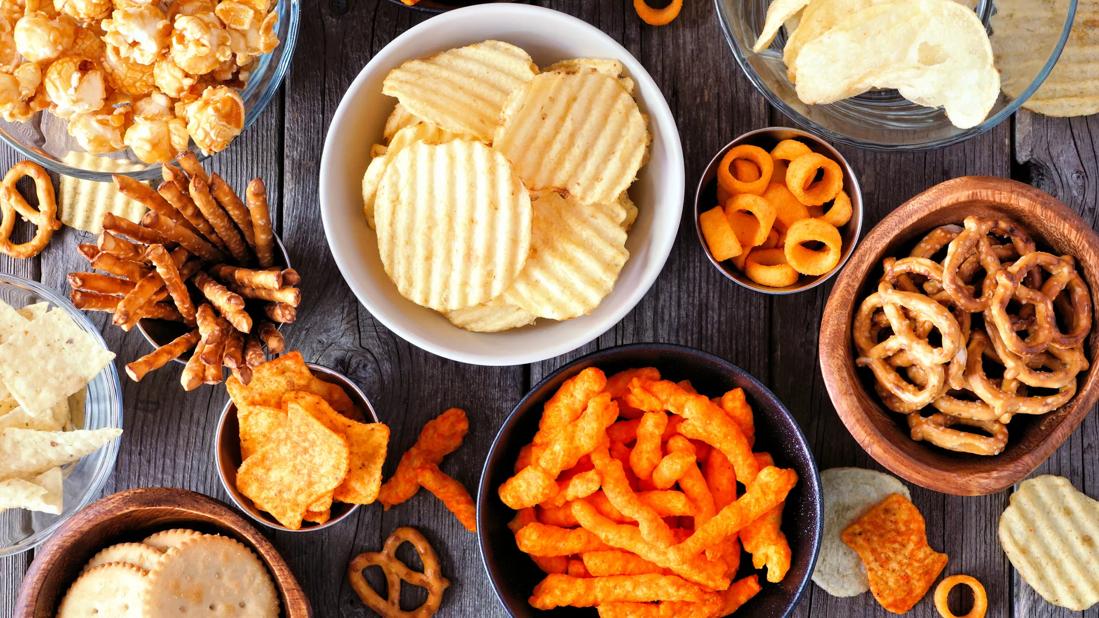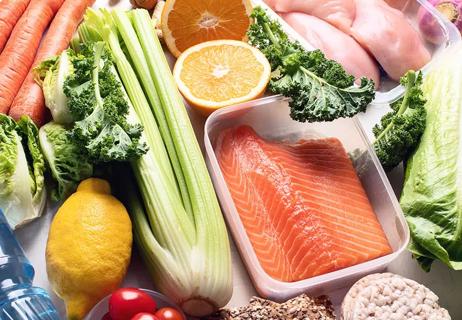Cut back on foods made with added sugars, trans fats, refined carbs, omega-6 fatty acids and processed meats

Inflammation can be like Dr. Jekyll and Mr. Hyde: In one way, it’s your body’s way of healing cell damage. But in overdrive, it becomes dangerous and can lead to conditions such as arthritis, heart disease, stroke and diabetes.
Advertisement
Cleveland Clinic is a non-profit academic medical center. Advertising on our site helps support our mission. We do not endorse non-Cleveland Clinic products or services. Policy
“What you eat can have an effect on inflammation, either causing a more pro-inflammatory response or helping to fight it,” explains registered dietitian Erin Coates, RDN, LD.
Coates says that inflammation is often triggered as a way to protect your health when your immune system notices anything foreign in your body. While intermittent inflammation can be protective, chronic inflammation has been linked to many serious illnesses.
“If you want to battle inflammation, start by taking a look in your kitchen,” advises Coates. “And when you make your grocery list, add fewer foods that cause inflammation and more anti-inflammatory foods like vegetables, fruits, nuts, beans, seeds and fatty fish.”
To help navigate the grocery aisle, Coates shares the types of inflammatory foods you should avoid or limit.
So, what are inflammatory foods?
First, let’s learn about what types of foods your body needs.
Your body is set up to absorb and use all the good stuff — vitamins, minerals and other nutrients — found in foods like fruits, vegetables and whole grains. Doing so helps your body function at its best.
But when you eat foods that cause inflammation — foods with added sugar, trans fats, omega-6 fatty acids, refined carbs or processed or red meats — your body isn’t equipped to handle them. This leads to inflammation in many ways. For example, eating a lot of added sugar or refined carbs can cause your blood sugar to spike.
Advertisement
“The digestion of certain foods typical of the Standard American Diet (SAD) can trigger a proinflammatory response in the body. Dietary factors that have been associated with increased inflammatory markers in the body include foods typically high in saturated and trans fat, added sugar, refined carbohydrates and red and processed meats,” explains Coates.
“The SAD diet is also typically rich in an abundance of ultra-processed foods characterized by a long list of ingredients, a high palatability, soft/sweetened beverages, refined bread products and sweets. The good news is that fighting chronic inflammation can be as easy as making simple changes to what you add in your grocery cart.”
Increasing scientific evidence supports the role of diet as a modifiable factor to help lower chronic inflammation in the body. Following a plant-based diet high in vegetables and fruits, and containing fiber-rich whole grains, legumes and healthy fats like fish has been associated with greater anti-inflammatory benefits.
“In fact, in a meta-analysis of 2,300 subjects from 17 clinical trials, it showed that greater adherence to the Mediterranean diet was associated with the most significant reductions in inflammatory biomarkers like interleukin-6 (IL-6) and C-reactive protein (CRP),” shares Coates.
When it comes to which inflammatory foods to avoid, there are five main categories of foods that increase inflammation. Coates outlines what foods cause inflammation and shares how to adjust what you eat.
The average American consumes around 17 teaspoons of added sugar per day. The current dietary guidelines suggest limiting added sugars to less than 10% of your daily caloric intake.
Consuming a diet high in simple sugars can raise your blood sugar levels rapidly and increase insulin levels, which promotes a pro-inflammatory state.
It has become increasingly difficult to avoid added sugars because food manufacturers add large doses to improve the flavor of many packaged foods. But research shows that consuming too much added sugar leads to chronic inflammation.
“While it’s OK to enjoy a sweet treat every now and then, we need to pay closer attention to how much of it we eat that is hidden in our food,” notes Coates.
While there are obvious sources of added sugars in candy, cookies and soda, the following are examples of foods with added sugar that you might not suspect:
When you digest something, the sugar enters your blood. Your body releases insulin to put sugar into the cell for energy. When a person is habitually consuming foods that spike their blood sugar rapidly throughout the day, insulin tries to store the excess in their fat cells, causing them to get larger. Over time, research shows this can lead to weight gain or insulin resistance, which is associated with other metabolic conditions like diabetes.
Advertisement
“To prevent these rapid spikes in blood sugar, it’s important to learn how to balance your plate with fiber, healthy fat and protein, as well as read labels for foods that are higher in added sugars,” Coates explains.
To lower your intake of added sugars, she recommends paying close attention to food labels:
And remember, there’s a difference between added sugars and natural sugars.
“Natural sugars are already present in foods like fruit and plain dairy products, while added sugars are extra and enhance the flavor of food. Added sugars can cause those spikes in blood sugar,” clarifies Coates.
“Natural sugars found in fruit and dairy don’t typically spike your blood sugar as quickly because they also contain fiber. If you pair fruit with lean protein and/or healthy fats it can help to slow that insulin spike, as well. Great examples of packaged foods with natural sugars are plain yogurt and some fruit and nut bars, while added sugars can be found in flavored yogurts and cereal.”
Advertisement
Researchers found that there’s no safe level of trans fats to consume. So, it’s recommended to aim for less than 1 gram of trans fat each day.
“Trans fats raise your ‘bad’ cholesterol (LDL) levels and lower ‘good’ cholesterol (HDL) levels. Both actions can increase your risk of developing heart disease, stroke and Type 2 diabetes,” explains Coates.
Food manufacturers create trans fats through the process of hydrogenation.
“Adding hydrogen to fat changes its texture, consistency and shelf life,” says Coates.
Examples of foods with trans fats include:
Food manufacturers know that trans fats are the latest bad guys on the block, so they’ve gotten creative with labeling. While many food labels clearly state “no trans fat” or “trans fat-free,” a product is still allowed to hide a half gram or less per serving in their products.
This is where it gets tricky because if you eat more than one serving, you have easily exceeded the one gram of trans fat or less per day limit.
“One way to find out if an item is truly free of trans fat is to look at the ingredients. If you see hydrogenated oils or partially hydrogenated oils in the ingredient list, then the food contains trans fat,” explains Coates.
Advertisement
She also recommends trying to limit portions to the serving size written on the label. It will help you stay under the 1-gram limit.
Processed meats have been salted, cured, fermented or smoked for flavor or preservation purposes. Research shows both processed and red meats are high in saturated fat, which causes inflammation.
Examples of red and processed meats include:
Studies have shown that higher intakes of these meats lead to cancer, heart disease and stroke, all of which go hand-in-hand with inflammation.
Coates offers these suggestions to help cut down on how much red or processed meats you’re eating:
Omega-6 fatty acids are fats that your body uses for energy. As your body can’t make them, you get them from the foods you eat.
Foods rich in omega-6s include:
“We need these fatty acids for normal growth and development. They also contribute to the good kind of inflammation in the body that helps heal you,” Coates says.
But research shows you need a healthy balance of omega-6s in your body. Consuming omega-3s (fats you get from foods such as salmon, walnuts and flaxseed) helps you achieve that balance. If you don’t have enough omega-3s and too many omega-6s, you create a pro-inflammatory response and consistent inflammation.
To restore your fatty-acid balance, Coates recommends:
Coates explains that refined carbohydrates are stripped of their nutrition and lack fiber.
“These processed carbs are becoming a mainstay in a lot of people’s diets,” she notes.
Refined carbs are primarily white flour products, including:
Research shows that refined carbs may cause inflammation in your body.
“Refined carbohydrates spike your blood sugar as rapidly as eating a dessert because they lack fiber, fat or protein to help slow their digestion,” she further explains. “This rapid spike in blood sugar contributes to a proinflammatory response.”
Instead of avoiding carbs altogether, replace refined carbs with 100% whole-grain alternatives like quinoa, oatmeal and brown rice.
“These types of carbohydrates are more complex and take longer to digest so they won’t spike your blood sugar as quickly,” she adds.
Sure, there are a lot of inflammation-causing foods. But instead of thinking of it as all the foods you can’t eat to avoid inflammation, choose a different approach by thinking of it as all the foods you can eat.
“To eat to fight inflammation, build a plate that focuses on colorful vegetables and fruits, fiber-rich carbohydrates, plenty of healthy fats like avocados, nuts and fatty fish, as well as leaner sources of proteins like beans, quinoa, eggs and chicken,” encourages Coates.
“If this overwhelms you, start with one small change. Ask yourself, What can I add more of? For example, many people are undereating fiber-rich vegetables. Perhaps thinking of simple ways to add more vegetables to your meals can be the first change you make to eating in a more anti-inflammatory way. Simple changes can make a big impact over time if you stay consistent in a gentle way.”
Learn more about our editorial process.
Advertisement

Raspberries are packed with nutrients that can reduce inflammation and prevent chronic diseases

Adding foods like fruits, vegetables, fatty fish and whole grains to your diet may help soothe inflammation

Foods and supplements that support your body

Edamame, lentils and chicken breast are good sources of protein

This powerful antioxidant does more than fight colds — it keeps you healthy inside and out

Eating this root vegetable can help support your eye, heart and brain health

The flavorful herb is full of antioxidants that may help regulate blood sugar

Too much sodium can cause high blood pressure and increase your risk of heart disease

The best parenting style balances enforcing rules and showing plenty of love

Tips include cutting back on sugar, focusing on exercise and managing stress

It can be harder to let go when you’ve invested time, energy and emotions — but it might be the healthier choice long term